Services on Demand
Journal
Article
Indicators
-
 Cited by SciELO
Cited by SciELO -
 Access statistics
Access statistics
Related links
-
 Cited by Google
Cited by Google -
 Similars in
SciELO
Similars in
SciELO -
 Similars in Google
Similars in Google
Share
Cuadernos de Administración
Print version ISSN 0120-3592
Cuad. Adm. vol.24 no.43 Bogotá July/Dec. 2011
* This article was carried out within of a course in the Doctoral Programme in Management: Business Network and Cooperation, University of Beira Interior, Portugal. This study was carried out in the period June-September 2009, and was supported by a Research Unit (NECE), financed by the FCT Science and Technology Foundation of Portugal. The article was received on: 12-02-11 and was accepted for publication on 03-11-11.
** PhD in Management, University of Beira Interior, Covilhã, Portugal, 2002; Master's degree in Management, University of Beira Interior, Covilhã, Portugal, 1997; Degree in Management, University of Beira Interior, Covilhã, Portugal, 1991. Assistant Professor of Entrepreneurship and SME Administration at the Department of Management and Economics, Beira Interior University, Portugal. Member of a Research Unit in Business Sciences (NECE). Email: mfranco@ubi.pt.
*** PhD in Management, University of Beira Interior, Covilhã, Portugal, 2011; Master's degree in Management, specialization in Educational Management , FURB, 2007; Degree in Electrical Engineering. Teacher and researcher in Management, Faculdade Cenecista de Joinville, Brazil. Email: emainardes@kesservice.com.br.
**** PhD student, University of Beira Interior, Covilhã, Portugal; Degree in Management and specialization in Hospital Management, Brazil, 2001. Member of a Research Unit in Business Sciences (NECE). Email: oliva.martins@gmail.com.
ABSTRACT
After several years of research in organizational networks, results are still fragmented and contradictory. The purpose of this study is to make a quantitative review of research into inter-organizational networks completed between 205 and 2008. It analyzes 275 articles out of a simple of 448 taken from journals registered with ISI and the conclusion is that topics such as relationships, trust, strategic alliances, innovation, internationalization and cooperation concentrate research interest in the field of inter-organizational networks. The authors stress the need for future studies to venture into new methodological approaches, in order to obtain beeper knowledge of this area.
Keywords: Inter-organizational networks, ISI journals, cooperation, strategic alliances.
JEL Classification: L14, L22, M10.
RESUMEN
Tras varios años de investigación en redes organizacionales, los resultados son aún fragmentarios y contradictorios. El objetivo de este estudio fue hacer una revisión cuantitativa de la investigación sobre redes interorganizacionales cumplida en el periodo 2005-2008. Se analizaron de 275 una muestra 448 artículos tomados de revistas registradas en la ISI y se concluyó que los temas de relaciones, confianza, alianzas estratégicas, innovación, internacionaliza-ción, y cooperación concentran los intereses de investigación en el campo de redes interorganizacionales. Los autores destacan la necesidad de que futuros estudios arriesguen nuevos enfoques metodológicos, para profundizar el conocimiento en esta área.
Palabras clave: Redes interorganizacionales, revistas ISI, cooperación, alianzas estratégicas.
Clasificación JEL: L14, L22, M10.
RESUMO
Depois de vários anos de pesquisa em redes organizacionais, os resultados ainda são fragmentários e contraditórios. O objetivo deste estudo foi fazer uma revisão quantitativa da pesquisa sobre redes interorganizacionais cumprida no período 2005-2008. Analisaram-se de 275 uma mostra 448 artigos extraídos de revistas registradas na ISI e concluiu-se que os temas de relações, confiança, alianças estratégicas, inovação, internacionalização, e cooperação concentram os interesses de pesquisa no campo de redes interorganizacionais. Os autores destacam a necessidade de que futuros estudos arrisquem novos enfoques metodológicos, para aprofundar o conhecimento nesta área.
Palavras chave: Redes interorganizacionais, revistas ISI, cooperação, alianças estratégicas.
Classificação JEL: L14, L22, M10.
Introduction
The model of organisations that compete in the market in isolation is losing some of its popularity. At present, we see the start of an outlook from which a set of organisations/ firms, in an interrelated way, hope to face up to -with greater possibilities of success- the uncertainty and complexity of a constantly changing environment. In fact, the formation of networks is necessary to attain long-term strategic objectives that organisations alone cannot reach. Therefore, due to the diversity of disciplines in the organisational field, organizations can no longer be analysed unattached from the context in which they find themselves, this being a relevant tendency in organisational studies (Casson, 1984; Parkhe, 1993; Gulati, 1995; Castells, 2000; Culpan, 2009).
The lack of established terms to refer to networks can be partly explained by the variety in types of alliances. For the purpose of this paper, the generic term of "inter-organizational networks" is used. It is defined as a group of organisations that involve exchange and sharing of different resources and capabilities in order to achieve a mutual strategic purpose.
In truth, it is only since the 1970s that inter-organisational networks have shown themselves to be a far-reaching business instrument in modern economies. However, only in the 1980s and 1990s did we see effective interest in studying networks. In those two decades a high number of theoretical and empirical studies were published on this subject (Ring and Van de Ven, 1994; Brown and Butler, 1995; Frankel and Whipple, 1996; Volery, 1996; Sousa, 1997; Schawald, 1998, among others).
Scientific investigation into inter-organisational networks followed a process of emergence and consolidation in the second half of last century. Numerous international conferences and congresses, the creation of investigation associations, the publication of many books with relevant investigations in the field (e.g., Culpan, 2002) and the appearance of diverse specialized journals, show the growing interest in scientific production in networks among organisations. In fact, the growth of inter-organisational networks have generated considerable interest in this topic among both academics and practitioners (Shah and Ewaminathan, 2008; Culpan, 2009) and they have grown in popularity over the last years (Dyer et al., 2001; Augustine and Cooper, 2009; Holmberg and Cummings, 2009).
The concept of networks emerged, according to Mattsson and Johanson (2006), in 1982, with the publication of two books: Firms in networks: A new view on competitiveness (Hagg and Johanson, 1982) and Marketing for competitiveness (Hammarkvist et al., 1982) in Sweden. Up to that moment, research into networks was directed mainly to the generation of theoretical concepts. But according to Mattsson and Johanson (2006), investigation into networks can also lead to results with practical relevance.
In this connection, we can also highlight the consolidation of a series of international periodical publications such as Journal of Business Venturing, Strategic Management Journal, Management International Review, Journal of Small Business Management, etc. and more recently, International Journal of Strategic Business Alliances. It is noted therefore that the importance of network investigation is demonstrated by the growing number of articles published on the topic in highly prestigious journals in the area of management and economics.
The advance of investigation in this field of knowledge has been strengthened by the attention given to national and international public bodies, as well as by introduction of this subject matter in the curricula of various universities. Diverse master's degree and Ph.D. theses on the most varied aspects of the network phenomenon, is also a factor showing the great interest in this area of investigation.
In this context and regarding the development process of the area of study of inter-organizational networks, the intention is to find out the current state of this business phenomenon in terms of investigation. In addition, it is considered that the multitude of issues that have been produced in recent years in this area requires study of what the main topics investigated are, the methodologies most frequently used, the main sources used in collecting the data, the techniques applied and fundamentally, which researchers have contributed most to the advance of knowledge in this domain.
To this end, the aim of this research is to study the situation of investigation into inter-organizational networks in the period 20052008. Other specific objectives defined forthis study are: (i) identification of the scientific production concerning inter-organisational networks published in isi journals in the period of analysis and (ii) analysis of the most productive authors in the period; the home countries of the investigations carried out; the topics dealt with; the investigation methods adopted; the target populations chosen for study; the origin of the data used; the instruments used for data collection; and the methods used for data analysis. Therefore, this study aims to contribute to investigation into inter-organisational networks, analysing a relevant part of the international scientific production.
Therefore, the second section takes a brief retrospective look at investigation into inter-organisational networks. The third section presents the methodological design followed in this study. Subsequently, the main results obtained are presented and then discussed. Finally, some conclusions are drawn and some recommendations are made for developing future investigations.
Investigation of Inter-organizational Networks
Some centres of empirical and theoretical investigation related to the subject of networks are situated in Scandinavian countries, particularly in the Uppsala school, and in the United Kingdom, with the special prominence of Lancaster University. The principle studies making most reference to the subject of networks are those by Johanson and Mattsson (1987), Hakansson and Snehota (1989) and the research carried out by Easton (1994). Indeed, the strategy of inter-organisational networks has been gaining prominence over various decades.
According to Ozman (2009), during the nineteen eighties and nineties there was a great increase in theoretical and empirical investigations into networks, in the literature on management and economics. During the nineteen eighties, there was an accumulation of studies focused on inter-organizational relationships and networks (Oliver and Ebers, 1998), however, the growth in number of these investigations in this decade did not guarantee a clear accumulation of knowledge or even conceptual consolidation, but on the contrary contributed to confused situations marked by the diversity of heterogeneous concepts (Ozman, 2009). This idea was also shared by Nohria and Eccles (1992).
On the other hand, Oliver and Ebers (1998) consider surprising the variety and wealth of investigations into inter-organisational relationships and networks in the nineteen nineties. Some of the researchers who marked this period were Nohria and Eccles (1992), Gulati (1995), Grandori and Soda (1995), Hakansson and Snehota (1995) and Ebers and Jarillo (1998). In general, these studies focus on: a set of recurring connections (resources, groups and information) between a set of actors (individuals, groups and organizations); identifying why some actors form specific connections in different circumstances; the consequences resulting from these connections and the position of the actors within these relationships (Oliver and Ebers, 1998).
The theories most often mentioned to explain inter-organisational networks and relationships up to the end of the nineteen nineties, according to the investigation by Oliver and Ebers (1998) based on analysis of a hundred and fifty eight articles on inter-organisational networks and relationships, were network theory (Johannisson, 1986, 1988) and resource dependency theory (Pfeffer and Salancik, 1978).
Because inter-organizational networks help access resources, resource-based theory (Wernerfelt, 1984) also appears to be an appropriate theoretical perspective for understanding these relationships. Das and Teng (2000), Park et al. (2004) and Mesquita et al. (2008) developed a resource-based theory, suggesting that access to complementary and additional resources is the main reason for entering into inter-organisational networks.
In fact, as noted by Culpan (2009), in inter-organisational networks, the major theoretical explanations can be: transaction cost economies (Coase, 1937; Williamson, 1975, 1981), internalisation theory (Rugman, 1986), industrial organisation perspective (Porter and Fuller, 1986), game theoretical perspective (Arend and Seale, 2005), resource-based view (Barney, 1991; Wernerfelt, 1984), knowledge-based view (Muthusamy and White, 2005), and network organisation theory (Johannisson, 1986, 1988; Ahuja, 2000; Bogatti and Foster, 2003). More recently, according to Culpan (2009), "real options theory" also provides a tool for managers to deal with uncertainty and strategic flexibility in inter-organisational networks.
In the field of social psychology, an important tradition in the study of inter-organisational relationships is the social network theory (Johannisson, 1987, 1990; Dubini and Al-drich, 1991) and the theory of social exchange (Blau, 1968; Wayne et al., 1997). These theories emphasize personal relationships, where trust, friendship, commitment and the share of values and beliefs are key elements in the network process. Unlike transaction costs theory, Williamson (1975) neglects to take into account matters related to trust and power, while in this same theory, control and power are variables found to be very close to each other.
The history of relationships, the social aspects in a network and its dynamics (more than its structural form), occupy a fundamental place in the theory developed by Johannisson (1987). For this investigator, just as for Dubini and Aldrich (1991) and Brass et al. (1998), a network of personal relationships represents an essential resource for a firm, whatever its size. Johannisson (1990) even states that through this type of network, a firm's leader mobilizes the social resources that ensure its growth. These socio-psychological aspects are also underlined, for example, by Cook and Emerson (1978), and Varamaki (1997). The first two authors are deservedly prominent in the field of sociology and provided a special contribution to the study of network structures. As for Sousa (1997), his fundamental contribution is to have facilitated analysis of relationships from a holistic perspective rather than a bilateral and sequential vision.
Organisations involved in a context of relationships based on trust, according to Gulati (1995) and Madhok (1995) can significantly reduce the search for new partners and can easily decide to join another organization/ firm in which they already place some trust. Varamaki (1996) argues that trust does not only play an important role in inter-organizational networks, but also has a strong influence on the continuity and maintenance of this relationship. According to Noo-teboom (1996), dynamics in relationships among people is only possible when there is trust. Trust forms an important dimension in such relationships, and as mentioned by Hirschman (1984), it can be increased with practice.
Granovetter (1985) argues that the social context in which transactions take place has a significant impact on actor behaviour. The same investigator described social networks and interpersonal relationships as mechanisms for reducing the opportunism referred to in transaction costs theory. The argument of Williamson (1975; 1985) is that due to the limited rationality and uncertainty, it is difficult to distinguish actors who cooperate and trust each other from those who will behave as opportunists.
Another particular aspect identified as relevant in the literature related to networks is the concept of commitment. According to Morgan and Hunt (1994) and Holm et al. (1996), relationships gradually involve commitments that are established by firms in the process. One study (Holm et al., 1996) showed that the relationships developed in a network have to be coordinated through the connection of partners' relationship processes. This commitment between two or more organisations is developed over time, and that creates interdependence and takes place within a wide network context. Consequently, social network theory (Gulati, 1998) and understanding of the meaning of commitment can contribute to explaining the dynamics of the network process.
Social exchange theory (Blau, 1964) has also brought together both the concept of power and that of equality to an analytical review of the network phenomenon. This theory has focused these two concepts on an analysis of reciprocity between two intervening parts, but according to Cook and Emerson (1978), the concepts of power and equality are fundamentally social phenomena studied in wide systems and not in isolation between two agents. Tjosvold and Weicker (1993) examined the role of power in a business network. These authors defined power as "the ability to impose goals, or the equivalent, as a control over resources" (p. 13). Power was a measure of the extent of dependence. It was widely argued that an excess of power is negative for understanding the interaction within and between organizations. Nooteboom (1996, p. 994) also defined power as "opportunities to reach some interest in a way that cannot be controlled". Thus, power can have an important role in networks, as a result of the desire of firms to ensure continuation of their businesses.
The traditional Uppsala model scrutinises different networks from the point of view of resources. Due to different levels of resources, the parties have various positions of power within networks. Johnson and Mattsson (1987) argue that within a network there must be division of work, which means inter-dependence between different firms. Thorelli (1986) conceptualises the power of any firm as the product of the division of work and the variety of the firm's missions.
According to Bienenstock and Bonacich (1997), all the theories of power in the context of networks have behavioural and structural components. The behavioural component concerns conception of the theory of how an individual makes his choices in a network. The structural component is related to identification of positions of power within a network. Nevertheless, in a given theory, the former component should not only consider the individual's choice but also how the complete pattern of choices and limitations in a network creates different types of power.
Previous studies on inter-organisational networks also present general models that assume the factors (e.g., negotiation, trust, commitment, distribution norms, and complementarity, among others) that drive partner attractiveness. From an evolutionary and dialectic perspective, some authors (Larson, 1992; Ring and Van de Ven, 1994; Varamaki, 1996; Sarkar et al., 2001; Fang et al., 2002; Pidduck, 2006; Bierly and Gallagher, 2007; Holmberg and Cummings, 2009) have been studying the pre-conditions for the formation of organisational networks.
The investigation of networks can involve many aspects and a vast range of resources, such as network size, its structure, its interaction processes, its behaviours, its influences and its capacities (Coviello, 2005). To sum up, various topics, dimensions and variables are connected to studying the phenomenon of inter-organisational networks, with analysis at the organisational, group and individual levels.
Study Design
Based on studies that made surveys of articles published and research carried out relating to inter-organisational networks and related subjects such as entrepreneurship, international business and others (Chandler and Lyon, 2001; Davidsson and Wiklund, 2001; Kirkman et al., 2006), this study can be characterised initially as exploratory and of a qualitative nature (Hair Jr et al., 2003). This qualitative exploratory research is documental, since the subject matter for study is articles published in scientific journals. Subsequently, the research takes on a descriptive character, with a quantitative method (Dens-combe, 2003; Hair Jr et al., 2003).
As the general aim of this study was to analyse the current condition of the most recent articles published in leading scientific journals on the subject of inter-organisational networks, at the qualitative exploratory stage of the research, a survey was made of scientific articles published in the principal management journals. Therefore, we first chose to identify which were the main scientific journals in management publishing studies on the subject of organisational networks. This choice followed some criteria: (i) management journals publishing in English; (ii) journals related to the isi (Institute for Scientific Information); and (iii) journals with the greatest number of articles on the subject of inter-organisational networks.
These criteria allowed us to find the principal management journals related to the subject of study. Firstly, English is the most influential language among scholars all over the world, as research published in other languages has less impact on the scientific community. Secondly, the choice of journals included in the isi is justified as this is a way of classifying the main scientific journals in the academic community. Finally, from inding the main management journals, in English and indexed by the isi, and dealing with inter-organisational networks, we chose the greatest number of articles dealing with this topic.
This method allowed a search according to specific expressions in the contents of scientific articles published in management journals indexed by the isi. Without limiting the years of publication, we found the amount of scientiic articles containing at least one of the following expressions: inter-firm linkages (Ahuja, 2000), strategic alliance (Kale et al., 2000; Culpan, 2009), cooperative alliances (Johnson et al., 1996), cooperative ventures (Lorange and Roos, 1990; Tallman and Shenkar, 1994), co-operative agreements (Schawald, 1998), inter-organizational networks (Clarke and Hallsworth, 1994), inter-organizational relationships (Gulati, 1998; Ring and Van de Ven, 2004; Antoncic and Prodan, 2008), inter-firm cooperation (Va-ramäki, 1996; Lui et al., 2006), cooperation amongfirms (Franco and Haase, 2009). This search led to inding 19 journals with a representative quantity of scientific articles containing one or more expressions related to the topic under study (over 5% of all articles published by each journal). See Table 1 these 19 journals.
Having defined the principal scientific journals, the same process was repeated (a search for articles containing the specific expressions on the subject of firm networks), but only in those journals listed above and in the period 2005 to 2008, since the aim of this study was to analyze the current state of the most recent articles on inter-organisational networks. Besides this justification, choice of the period 2005 to 2008 was due to the great amount of articles on the subject studied during this 4 year period. Previous analyses of periods before 2005 showed a much lower quantity of articles than during the period 2005-2008, which demonstrates a greater interest in the subject from 2005, therefore justifying the period chosen.
This process resulted in 448 scientific studies published in these 19 journals. The study was therefore transversal, concerning the period of time, to ensure fulfilment of the defined objectives, the sample being characterised as one of convenience (Patton, 1990). Consequently, the 448 articles found were read, in order to determine if there really was some association with the study of networks. After confirming this, the articles were separated for a new evaluation and categorisation (Table 1).
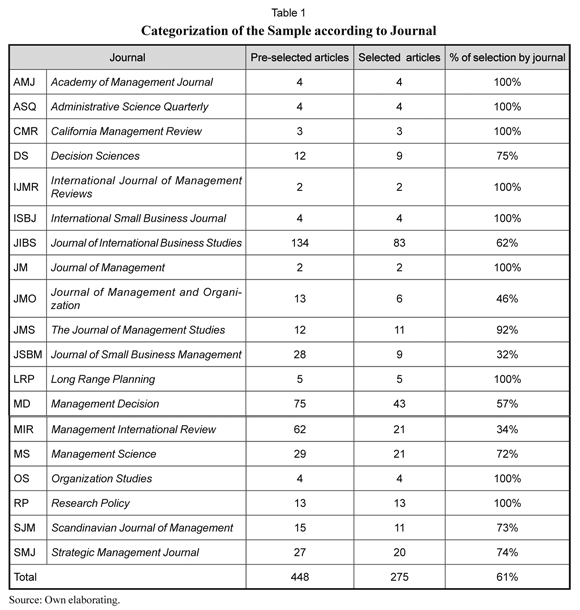
In these circumstances, a total of 275 scientific articles published in the selected journals were found (Table 1). These 275 articles went on to form the second stage of research, this being quantitative descriptive. At this stage, the initial purpose was to identify, in the studied articles, the following variables: the authors of the articles (personal identification and home country); the themes/subjects approached in dealing with inter-organisational networks; investigation methods used; target populations chosen for the study; origin of the data used; data collection instruments adopted; and methods used for data analysis. On concluding these analyses of each of the articles assessed, the data were joined in a single table and analysed through univa-riate descriptive statistics. The results were combined in tables and described in summary form.
Data Analysis and Discussion
In analysing the data, first we aimed to characterise the sample of selected articles. The next step was to identify the authors who published most in the period 2005-2008, as well as the home countries of the authors of the articles on the subject of inter-organisational networks. Analysis followed of the most frequently investigated themes/subjects, the most common methods in the research carried out, the most frequent target populations, the origin of the data used in empirical investigations, data collection instruments used, and the most common methods of data collection and analysis in the 275 selected articles.
Sample Characterization. Regarding the sample, an analysis was made of the evolution of the most recent articles on inter-organisational networks. Table 2 shows the results obtained.
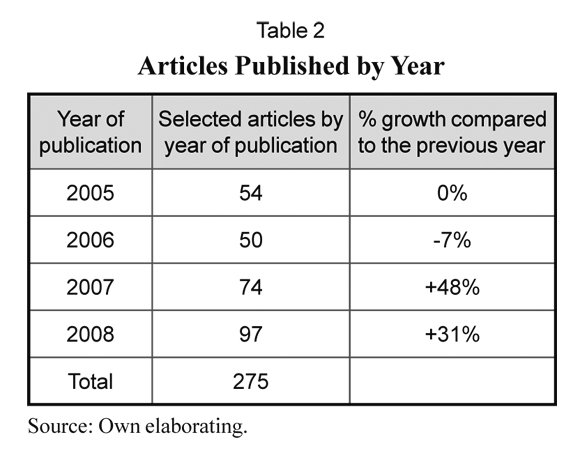
The results obtained reveal an increase in articles published in recent years. This demonstrates that the subject of organisational networks has gained importance of late (Dyer et al., 2001; Augustine and Cooper, 2009). The main reasons for these new developments and participation in networks, according to Cozzarin and Percival (2006), Felman et al. (2006), Forbes and Wield (2008), Huang and Chang (2008), Percival and Cozzarin (2008) and Weber and Khademian (2008), are due to the new requirements of the rapid progress and spread of technologies associated with the new technical-economic paradigm, based on information technology. This issue is increasingly present in the life of firms, leading to academic interest in investigating the subject to find solutions to the diverse questions involved in inter-organisational networks.
Authors and Countries. A second analysis aimed to identify the authors who published most in the period 2005 to 2008. The results are presented in Table 3.
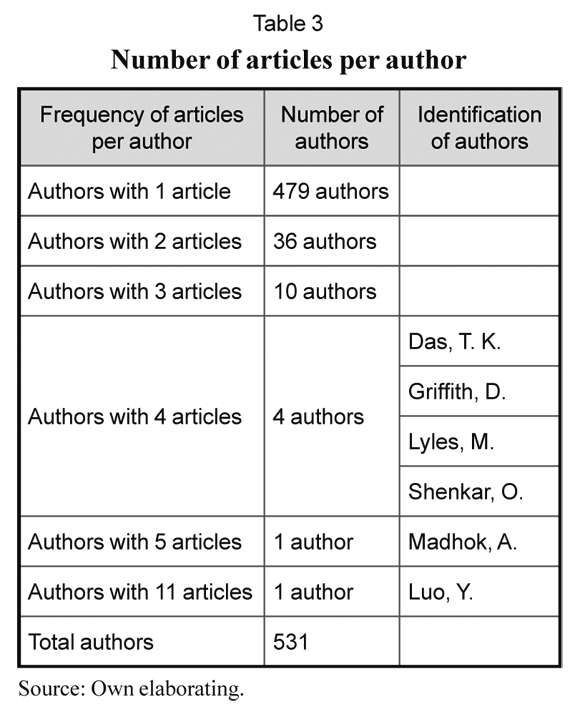
The evidence found shows a total of 531 different authors, from 32 countries (Table 4). The great majority of authors published only one article on the subject investigated in the 4-year period. On the other hand, we see that some authors stand out due to the number of articles published in the same period of 2005 to 2008.
The exceptional performance of the author Yadong Luo stands out. This author published 11 articles on the subject of networks in isi journals in a 4-year period. Of special note are also Anoop Madhok (5 articles), T. K. Das, David Griffith, Marjorie Lyles and Oded Shenkar (4 articles each). It is also important to note that 10 authors presented 3 articles and another 36 published 2 studies. Considering the relatively short period of time (4 years), more than one study published shows good performance in terms of scientific investigation.
However, this analysis was not limited to the authors themselves, as another important factor was also considered, i.e. identification of the home countries of the authors of the published studies (Table 4).
Based on Table 4, we find that researchers from English-speaking countries dominate what is published in the field, with usa standing out with more than 37% of the investigations published in isi journals on inter-organisational networks. Taking the United Kingdom (with just over 8%), Canada (more than 6%) and Australia (almost 6%), we observe that more than 50% of investigations into networks relate to the English-speaking world.
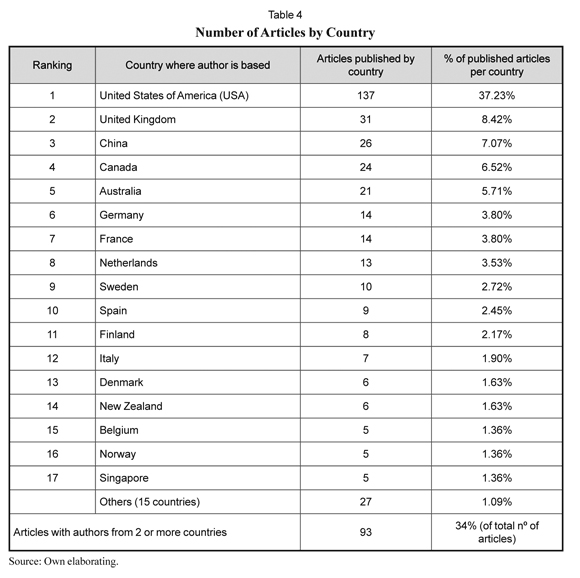
Another prominent country is China, since this emerging market is becoming an important centre of investigation into organisational networks. Indeed, China has shown above-average growth, and part of this Chinese development is due to forming partnerships and alliances with organisations all over the world, being "fertile ground" for investigation of the subject dealt with here.
As for Europe (other than the United Kingdom), there is deemed to be a balanced distribution of articles among various countries in this continent with Germany, France and Netherlands originating a considerable share of European investigations. It is also important to highlight the presence of various European countries with much smaller populations than the leaders in terms of publications. In a calculation of scientific productivity on inter-organisational networks per habitant, countries like the Netherlands, Sweden, Finland, Denmark, Belgium and Norway would be well in front of countries like usa and China, indicating a good performance in scientific productivity in relative terms.
A special factor is the shared carrying out of investigations among countries. Around 34% of the studies analysed involved researchers from more than one country. This fact demonstrates that part of the investigation into inter-organisational networks involves international networks, alliances and partnerships. This phenomenon shows the globalised situation in the world today. We can expect continued growth of international studies on the subject of firm networks, as after all, one of the ways to accelerate and facilitate internationalisation is the creation/formation of networks (Coviello and Munro, 1997). As initial mobilisation of internationalisation is facilitated by networks, we can assume these links emerge prior to internationalisation (Coviello, 2006). Inter-organisational relationships are widely recognized as influential in the process of internationalisation (Harris and Wheeler, 2005).
Themes/Subjects Investigated. The topics/ issues that have aroused most interest in network investigation appear in Table 5. After initial analysis of each article and grouping of the themes/subjects dealt with in each study, the following data were obtained.
399 subjects were found to be dealt with in the 275 articles analysed. These subjects were categorised and then quantified. Summarising, relationships, network and trust in inter-organisational networks was the theme most dealt with by authors researching in the area of networks.
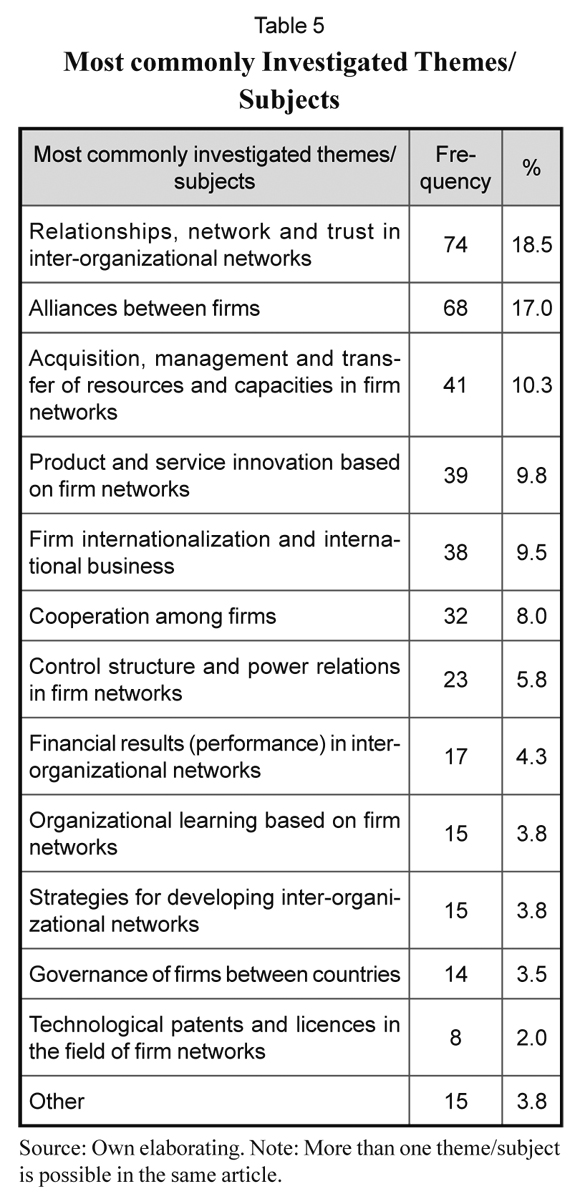
This was to be expected, as trust is an essential and "existential" dimension in network dynamics. One of the main antecedents of trust is communication, which can be generally defined as formal and informal sharing of meanings and information in a network (Morgan and Hunt, 1994). A climate of trust allows inter-organisational networks to be effective, since the necessary information -both economic and non-economic- for decision-making circulates more freely (Márquez-García et al., 1998). Trust increases the flow of information in a relationship (Mad-hok, 1995; Woolthuis and Hillebrand, 1997).
Another dominant theme was investigation to evaluate alliances between organisations. In a global situation, inter-firm alliances become important for organisations' growth. In this context, there is justification for the number of studies dealing speciically with alliances between irms, concerning performance, descriptive characteristics of alliances and other topics.
Research about acquisition, management and transfer of resources and capacities in firm networks also deserves mention. This subject tends to be one of the principle objectives of inter-organizational networks, and is also a subject scholars in this ield have studied considerably. The transfer of knowledge and technology dominates studies related to this speciic subject (Muthusamy and White, 2005).
In this context, various authors assume the objective of an innovation network will be to reduce uncertainties through cooperation among actors from different areas of competence, aiming to produce the missing information; eficiency gains due to division of the work; share of costs and risks; and access to external knowledge, as well as control of knowledge (Lazaric and Lorenz, 1997b; Pyka and Küppers, 2002; Cozzarin and Percival, 2006; Weber and Khademian, 2008).
We also highlight the presence of studies dealing with innovation, internationalisation (with special prominence of formation of joint ventures) and cooperation, themes which form part of the study of inter-organisational networks and which require more study for comprehension of the situation of an organisation and its business partners.
Investigation Methods. Another aspect analysed in the selected studies was the methodological approach adopted to carry out investigations. The results found are presented in Table 6.
The first point to highlight in the studies analysed was the significant presence of conceptual articles (26%). This fact can be interpreted in two different ways: either the field is maturing and such articles systematise knowledge in the area; or the field is still recent and conceptual articles are theoretical proposals to explain something which is not yet well-known. From a deeper analysis of these articles, it is concluded this indicates previous studies allowed theoretical development in the field, as the basis of a conceptual article is the systematisation of acquired knowledge. This observation demonstrates a certain maturity in investigation into inter-organisational networks.
There was also evidence of quantitative-descriptive investigative articles. This result shows the theme of inter-organizational networks is scientifically mature, as in fact exploratory studies, mainly of a qualitative nature, and case studies, are in the minority. In areas where exploratory investigation, often based on case studies, is high, we can consider them to be emerging areas where much knowledge can be obtained.
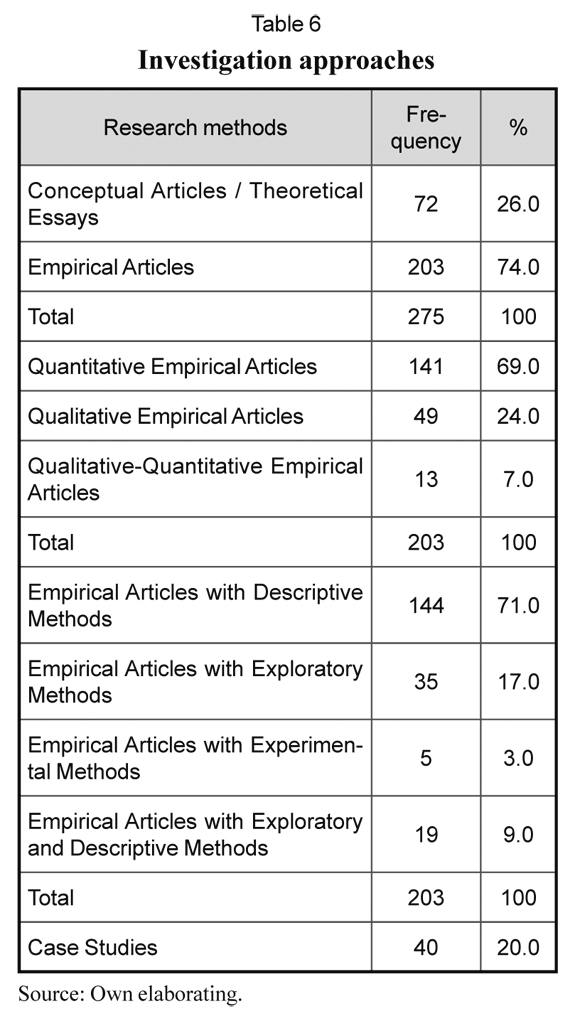
Target Population. A fundamental point in investigating any topic is the correct identification of the target populations to be researched. In the case of networks, there is convergence of the main target population studied, as is seen in Table 7.
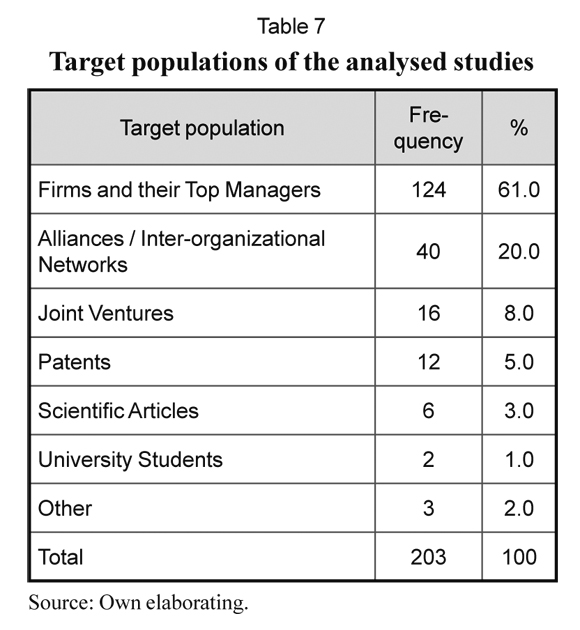
Table 7 reveals that research universes were centred on firms (especially investigations related to their top managers) and inter-firm alliances/networks. This focus proves that the target populations of studies of inter-organisational networks are duly delimited, and so demonstrating that the area of studies into firm networks tends to be scientifically mature.
Data Used. Another point analysed was the origin of the data used in the studies identified. Based on the results obtained, it is understood that the majority of data is primary (56%), i.e. they were obtained in the field by the researchers themselves. However, a reasonable number of studies used secondary data (29%). Therefore, it is worth highlighting the presence of data previously collected and which "subsidise" a significant part of research into inter-organizational networks. These databases allow extension and dissemination of studies about networks.
Only 31 studies (15%) - articles analysed -used documents as origin of data.
Data-collecting Instruments. Analysis follows of those instruments used for collecting data, when these were primary. A summary of this survey is presented in Table 8.
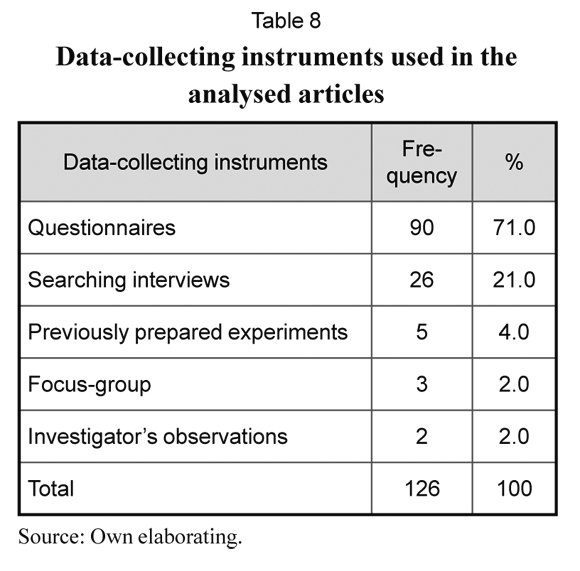
Considering that most studies are quantitative, it is understandable that the main instrument for obtaining data was the questionnaire for carrying out surveys. In 13 studies, the authors used more than one data-collecting instrument, as these were studies of a qualitative-quantitative nature. So in these cases, questionnaires were preceded by searching interviews.
Following these methodological procedures and adopting various instruments for obtaining data (triangulation of data sources), such as thorough qualitative analyses and studies based on questionnaires, various units of analysis can be attained, according to Osborn and Hagedoorn (1997) and Patton (1990).
It was also observed there is little new in this question. As alternative methods for obtaining data, we can highlight experiments, which is somewhat rare in researches in applied social science.
Data Analysis. As the final aspect of analysis, we identified the most common methods of analysing the data obtained. These results are presented in Table 9.
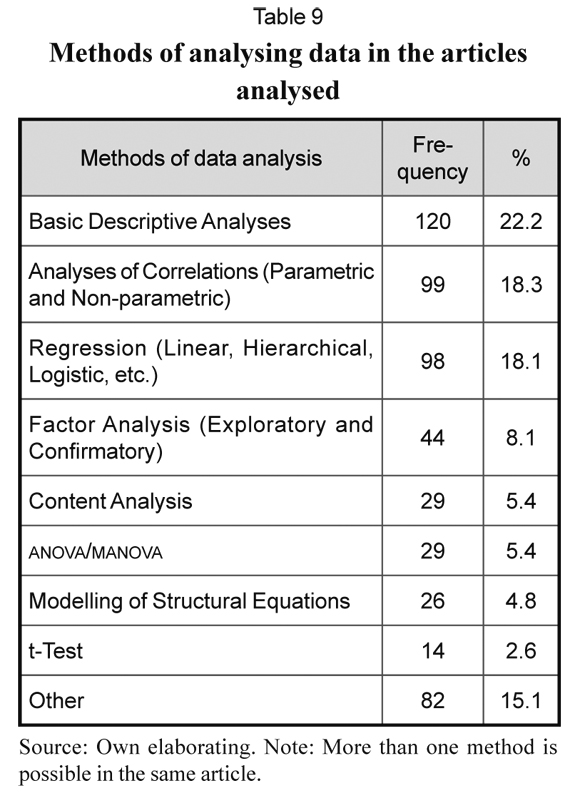
Considering that most empirical studies were quantitative, we can expect the most frequently used methods for data analysis to be quantitative methods, especially multiva-riate, and so basic descriptive analyses were most common in the articles analysed. This result is not surprising as the great majority of quantitative investigations present averages, standard deviations and others as their initial results. As the studies analysed were in the main hypothetical-deductive, multivaria-te analyses of correlations (both parametric and non-parametric) were widely used. This is the most common type of analysis when testing hypotheses.
Another common method, but used to analyse dependence between variables, is regression. This technique was also frequently used to identify factors influencing certain variables (organizational performance, for example). In quantitative terms, factor analysis (grouping of variables), anova/manova (variance and co-variance), modelling of structural equations (identifying interdependence between variables), and the t test (test of hypotheses) also stood out. These were the most usual methods in the quantitative investigations analysed.
The qualitative information obtained was most frequently analysed using content analysis (Patton, 1990; Varamaki, 1996). This type of analysis consists of a process of identification, codification and categorisation of primary patterns of the information obtained, i.e. analysis of the content of interviews and documents, as well as observations made from case studies carried out, with the aim of quantifying qualitative data.
Bearing in mind that just a minority of studies about networks are qualitative, we understand a large number of authors on the subject have a more positivist vision and collection of qualitative data tends to be quantified.
Conclusions and Future Directions
Considering the importance of inter-organisational networks, this study aimed to analyse the current state of investigation relating to the subject. Contemplating a 4-year period (2005-2008), a considerable volume of investigations was found on the subject of organisational networks (275 articles published in 19 isi journals). This quantity of investigations confirms current academic interest in inter-organisational networks, as the volume of articles relating to this subject has grown significantly over the years.
In the thorough analysis carried out, i.e. after consulting the 275 articles, we can say that a large part of the investigation is of English-speaking origin, and this reflects the importance of inter-organisational networks for firms in countries like the usa, the United Kingdom, Canada and Australia. Special mention should be made of the investigations in China, where this country surprises with its economic growth, and apparently this situation is reflected in its scientific production. In further investigation, researchers also need to pay particular attention at the country of origins of the samples studies used.
From social networks to organisational typology in networks, among other paradigms, various disciplines have developed within this field of investigation, namely organisational theories and behaviour, strategic management, market studies, sociology and psychology. Interdisciplinary studies of inter-organisational networks would provide a broader perspective in understanding such inter-organisational phenomenon. In ge-
neral terms, various scientiic articles have been published in this area and these show considerable progress in understanding the working methodology of inter-organisational networks, i.e. how they are structured, the operation mechanism and even the premises marking their evolution and development. This is conirmed by identiication of the main themes/subjects dealt with in the studies analysed. Relationships, trust, network, alliance management, management of resources and capacities among partner irms, innovation, internationalisation and cooperation are frequent issues in investigations that aim to extend knowledge of networks. These themes include a vast area of social sciences and multidisciplinary studies that can develop knowledge relating to networks.
Another fact worth stressing is the scientific maturity of the subject of inter-organisational networks. This aspect can be seen from: (1) the amount of conceptual articles published; (2) the predominance of quantitative-descriptive investigations; (3) the delimitation of studies in the situation of firms and their alliances; (4) the significant presence of investigations using secondary data; and (5) statistical conirmation of the results obtained. This evidence shows that the subject of inter-organisational networks, irst investigated in the 1970s, has evolved over more than 30 years, forming a theoretical framework that aims to sustain business practices. Although this subject is in a state of constant evolution, we can consider the knowledge developed up to now tends to present a good degree of explanation of the phenomenon. This conclusion comes from the empirical evidence found in the articles analysed.
The authors' opinions can be understood, highlighting that from the documental research carried out, there seems to be sufficient scientific studies dealing with inter-organisational functioning as a concept or formal and theoretical paradigm. but when the desire is to study its practical applicability. we find gaps in the research. Indeed, despite diverse studies in the area. its use and adoption have received diverse criticism.
In spite of studies relating to networks showing their importance in management activities, great difficulty persists when the intention is to apply this phenomenon as an analytical tool. Investigations into networks should be more conceptual as regards considerations and clearer in demonstrating how to effect. through them. accumulation of knowledge in this field.
The majority of empirical studies about inter-organisational networks are carried out in different sectors and under different conditions. This diversity makes it difficult to reach general conclusions supported by empirical evidence. Besides. many of the investigations carried out are focused on a limited period of time (cross sectional character). and therefore more effort would be needed to be made towards studying inter-organisational networks through longitudinal analysis.
Many of the studies carried out do not incorporate dynamic elements in studying inter-organisational networks and therefore more investigation of a qualitative nature is necessary. i.e. case studies analysed over longer periods of time. This type of perspective will let us see how some aspects evolve in such a complex process as that of inter-organisational networks.
References
1. Ahuja, G. (2000). The duality of collaboration: inducements and opportunities in the formation of interfirm linkages. Strategic Management Journal, 21 (3), 317-343. [ Links ]
2. Antoncic, B. and Prodan, I. (2008). Alliances, corporate technological entrepreneurship and firm performance: testing a model on manufacturing firms. Technovation, 28 (5), 257-265. [ Links ]
3. Arend, R. J. and Seale, D. A. (2005). Modeling alliance activity: an iterated prisoners' dilemma with exit option. Strategic Management Journal, 26 (11), 1057-1074. [ Links ]
4. Augustine, M. S. and Cooper, C. D. (2009). Getting the most from strategic partnering: A tale of two alliances. Organizational Dynamics, 38 (1), 37-51. [ Links ]
5. Barney, J. (1991). Firm resources and sustained competitive advantage. Journal of Management, 17, 99-120. [ Links ]
6. Bienenstock, E. J. and Bonacich, P. (1997). Network exchange as a cooperative game. Rationality & Society, 9 (1), 37-67. [ Links ]
7. Bierly, P. E. and Gallagher, S. (2007). Explaining alliance partner selection: Fit, trust and strategic expediency. Long Range Planning, 40 (2), 134-153. [ Links ]
8. Blau, P. (1964). Exchange and power in social life. New York: Wiley. [ Links ]
9. Blau, P. (1968). The hierarchy of authority in organizations. American Journal of Sociology, 73 (4), 453-467. [ Links ]
10. Bogatti, S. P. and Foster, P. C. (2003). The network paradigm in organizational research: A review and typology. Journal of Management, 29 (6), 991-1013. [ Links ]
11. Brass, D. J.; Butterfield, K. D.; and Skaggs, B. C. (1998). Relationships and unethical behavior: A social network perspective. The Academy of Management Review, 23 (1), 14-31. [ Links ]
12. Brown, B. and Butler, J. E. (1995). Competitors as allies: A study of entrepreneurial networks in the US wine industry. Journal of Small Business Management, July, 57-66. [ Links ]
13. Casson, M. (1984). The theory of vertical integration: A survey and synthesis. Journal of Economic Studies, 11 (2), 3-43. [ Links ]
14. Castells, M. (2000). Materials for an exploratory theory of the network society. The British Journal of Sociology, 51, 5-24. [ Links ]
15. Chandler, G. and Lyon, D. (2001). Issues of research design and construct measurement in entrepreneurship research: The past decade. Entrepreneurship Theory and Practice, 25 (4), 101-113. [ Links ]
16. Clarke, I. E. and Hallsworth, A. (1994). Interorganizational networks and location investment decisions. International Journal of Retail & Distribution Management, 22 (6), 38-45. [ Links ]
17. Coase, R. H. (1937). The nature of the firm. Economica, 4, 386-405. [ Links ]
18. Cook, K. S. and Emerson, R. M. (1978). Power, equity and commitment in exchange networks. American Sociological Review, 43, 721-739. [ Links ]
19. Coviello, N. (2005). Integrating qualitative and quantitative techniques in networks analysis. Quantitative Market Research, 18, 39-60. [ Links ]
20. Coviello, N. (2006). The network dynamics of international new ventures. Journal of International Business Studies, 37, 713-731. [ Links ]
21. Coviello, N. and Munro, H (1997). Network relationships and the internationalization process of small software firms. International Business Review, 6 (4), 361-386. [ Links ]
22. Cozzarin, B. P. and Percival, J. C. (2006). Complementarities between organizational strategies and innovation. Economics of Innovation and New Technology, 15 (3), 195-217. [ Links ]
23. Culpan, R. (2002). Global business alliances: Theory and practice. Quorum Books, Westport, CT. [ Links ]
24. Culpan, R. (2009). A fresh look at strategic alliances: research issues and future directions. International Journal of Strategic Business Alliances, 1 (1), 4-23. [ Links ]
25. Das, T. K. and Teng, B. (2000). A resource-based theory of strategic alliances. Journal of Management, 26 (1), 31-61. [ Links ]
26. Davidsson, P. and Wiklund, J. (2001). Levels of analysis in entrepreneurship research: current research practice and suggestions for the future. Entrepreneurship Theory and Practice, 25 (4), 81-99. [ Links ]
27. Denscombe, M. (2003). The good research guide: for small-scale social research projects, 2 ed., Philadelphia: McGraw-Hill. [ Links ]
28. Dyer, J. H.; Kale, P.; and Singh, H. (2001). How to make strategic alliances work. Sloan Management Review, 42, 37-43. [ Links ]
29. Easton, G. (1994). Industrial networks: A review. In B. Axelsson and G. Easton (Eds.), Industrial networks. A new view of reality. London: Routledge. [ Links ]
30. Ebers, M. and Jarillo, C. (1998). The construction, forms and consequences of industry networks. International Studies of Management and Organization, 47 (4), 3-21. [ Links ]
31. Fang, S. R.; Chiang, S. C.; and Fang, S. C. (2002). An integrative model for partner relationship. An empirical research of small and middle firms. Journal of Management, 19 (4), 615-645. [ Links ]
32. Felman, M.; Gertler, M.; and Wolfe, D. (2006). University technology transfer and national systems of innovation: Introduction to the special issue of industry and innovation. Industry and Innovation, 13 (4), 359-370. [ Links ]
33. Forbes, N. and Wield, D. (2008). Innovation dynamics in catch-up firms: Process, product and proprietary capabilities for development. Industry and Innovation, 15 (1), 69-92. [ Links ]
34. Franco, M. and Haase, H. (2009). Entrepreneurial orientation from learning alliances: A study towards business performance. Small Business Review/Piccola Imprensa, 2, 75-99. [ Links ]
35. Frankel, R. and Whipple, J. S. (1996). Alliance formation motives: A comparison of international perspectives. The International Journal of Logistics Management, 7 (2), 19-31. [ Links ]
36. Grandori, A. and Soda, G. (1995). Inter-firm networks: Antecedents, mechanisms and forms. Organization Studies, 16 (2), 183-214. [ Links ]
37. Granovetter, M. (1985). Economic action and social structure: The problem of Embeddedness. American Journal of Sociology, 91 (3), 481-510. [ Links ]
38. Gulati, R. (1995). Does familiarity breed trust? The implication of repeated ties for contractual choice in alliances. Academy of Management Journal, 38 (1), 85-112. [ Links ]
39. Gulati, R. (1998). Alliances and networks. Strategic Management Journal, 19 (4), 293-317. [ Links ]
40. Hägg, I. and Johanson, J. (1982). Företag i Nätverk: En Ny Syn Pâ Konkurrenskraft (Firms in Networks: A New View on Competitiveness). Stockholm: SNS. [ Links ]
41. Hair Jr., J. F.; Babin, B.; Money, A. H.; and Samuel, P. (2003). Essentials of Business Research Methods. New Jersey: John Wiley & Sons. [ Links ]
42. Hakansson, H. and Snehota, I. (1989). No Business is an Island: The network concept of business strategy. Scandinavian Journal of Management, 5 (3), 187-200. [ Links ]
43. Hakansson, H. and Snehota, I. (1995). Business networks. London: Routledge. [ Links ]
44. Hammarkvist, K. O.; Hakansson, H.; and Mattsson, L. G. (1982). Marknadsföring för Konkurrenskraft (Marketing for Competitiveness). Lund: Liber. [ Links ]
45. Harris, S. and Wheeler, C. (2005). Entrepreneurs relationships for internationalization: Functions, origins and strategies. International Business Review, 14, 187-207. [ Links ]
46. Hirschman, A. O. (1984). Against parsimony: Three easy ways of complicating some categories of economic discourse. American Economic Review, 74 (2), 88-96. [ Links ]
47. Holm, D. B.; Eriksson, K.; and Johanson, J. (1996). Business networks and cooperation in international business relationships. Journal of International Business Studies, Special Issue, 1033-1053. [ Links ]
48. Holmberg, S. R. and Cummings, J. K (2009). Building successful strategic alliances: Strategic process and analytical tool for selecting partner industries and firms. Long Range Planning, 42 (2), 164-193. [ Links ]
49. Huang, H. C. and Chang, C. W. (2008). Embedded ties and the acquisition of competitive advantage. Journal of Intellectual Capital, 9 (1), 105-121. [ Links ]
50. Johannisson, B. (1986). Network strategies: Management technology for entrepreneurship and change. International Small Business Journal, 5 (1), 19-30. [ Links ]
51. Johannisson, B. (1987). Beyond process and structure: Social exchange networks. International Studies of Management and Organisation, 17 (1), 3-23. [ Links ]
52. Johannisson, B. (1988). Business formation. A network approach. Scandinavian Journal of Management, 4 (3/4), 83-99. [ Links ]
53. Johannisson, B. (1990). Economies of overviewguiding the external growth of small firms. International Small Business Journal, 9 (1), 32-44. [ Links ]
54. Johanson, J. and Mattsson, L. (1987). Interganizational relations in industrial systems: A network approach compared with the transaction-cost approach. International Studies of Management & Organization, 17 (1), 34-48. [ Links ]
55. Johnson, J. L.; Cullen, J. B.; Sakano, T.; and Take-nouchi, H. (1996). Setting the stage for trust and strategic integration in Japanese-U.S. cooperative alliances. Journal of International Business Studies, Special Issue, 981-1004. [ Links ]
56. Kale, P.; Singh, H.; and Perlmutter, H. (2000). Learning and protection of proprietary assets in strategic alliances: Building relational capital. Strategic Management Journal, 21, 217-237. [ Links ]
57. Kirkman, B.; Lowe, K.; and Gibson, C. (2006). A quarter century of culture's consequences: A review of empirical research incorporating Hofstede's cultural values framework. Journal of International Business Studies, 37, 285-320. [ Links ]
58. Larson, A. (1992). Network dyads in entrepreneurial settings: A study of the governance of exchange relationships. Administrative Science Quarterly, 37, 76-104. [ Links ]
59. Lazaric, N. and Lorenz, E. (1997). Trust and organizational learning during inter-firm cooperation. In N. Lazaric and E. Lorenz (Eds.), The Economics of Trust and Learning. Cheltenham: Edward Elgar. [ Links ]
60. Lorange, P. and Roos, J. (1990). Formation of cooperative ventures: Competence mix ofthe management teams. Management International Review, 30, Special Issue, 69-86. [ Links ]
61. Lui, S. S.; Ngu, H.; and Yon, A. H. (2006). Coercive strategy in interfirm cooperation: mediating roles interpersonal and inter-organizational trust. Journal of Business Research, 59 (4), 466-474. [ Links ]
62. Madhok, A. (1995). Revisiting multinational firms' tolerance for joint ventures: a trust-based approach. Journal of International Business Studies, 26 (1), 117-138. [ Links ]
63. Márquez-García, A. M.; Hernández-Ortiz, M. J.; Vallejo-Martos, M. C.; and Cañas-Lozano, L. (1998, September 7-9). The role of trust in Cooperation relationships. Paper presented at the VII International Conference AEDEM, Istanbul, Turkey. [ Links ]
64. Mattsson, L. G. and Johanson (2006). Discovering market networks. European Journal of Marketing, 40 (3/4), 259-274. [ Links ]
65. Mesquita, L. F.; Anand, J.; and Brush, T. H. (2008). Comparing the resource-based and relational views: Knowledge transfer and spillover in vertical alliances. Strategic Management Journal, 29 (9), 913-941. [ Links ]
66. Morgan, R. M. and Hunt, S. D. (1994). The commitment-trust theory of relationship marketing. Journal of Marketing, 58, 20-38. [ Links ]
67. Muthusamy, S. and White, M. (2005). Learning and knowledge transfer in strategic alliances: a social exchange view. Organization Studies, 26 (3), 415-441. [ Links ]
68. Nohria, N. and Eccles, R. G. (1992). Networks and Organizations: Structure, Form and Action. Harvard Business School Press, Harvard. [ Links ]
69. Nooteboom, B. (1996). Trust, opportunism and governance: A process and control model. Organization Studies, 17 (6), 985-1010. [ Links ]
70. Oliver, A. and Ebers, M. (1998). Networking network studies: An analysis of conceptual configurations in the study of inter-organizational relationships. Organization Studies, 19 (4), 549-583. [ Links ]
71. Osborn, R. N. and Hagedoorn, J. (1997). The institutionalization and evolutionary dynamics of inter-organizational alliances and networks. Academy of Management Journal, 40 (2), 261-278. [ Links ]
72. Ozman, M. (2009). Inter-firm networks and innovation: A survey of literature. Economics of Innovation and New Technology, 18 (1), 39-67. [ Links ]
73. Park, N. K.; Mezias, J. M.; and Song, J. (2004). A resource-based view of strategic alliances and firm value in the electronic marketplace. Journal of Management, 30 (1), 7-27. [ Links ]
74. Parkhe, A. (1993). Strategic alliance structuring: A game theoretic and transaction cost examination of interfirm cooperation. Academy of Management Journal, 36 (4), 794-829. [ Links ]
75. Patton, M. Q. (1990). Qualitative Evaluation and Research Methods. California: Sage Publications. [ Links ]
76. Percival, J. C. and Cozzarin, B. P. (2008). Complementarities affecting the returns to innovation. Industry and Innovation, 15 (4), 371-392. [ Links ]
77. Pfeffer, C. and Salancik, G. (1978). The External Control of Organization. A Resource Dependence Perspective. New York: Harper and Row Publishers. [ Links ]
78. Pidduck, A. B. (2006). Issues in supplier partner selection. Journal of Enterprise Information Management, 19 (3), 262-276. [ Links ]
79. Porter, M. E. and Fuller, M. B. (1986). Coalitions and global strategy. In M. E. Porter (Ed.), Competition and Global Industries (pp. 315-343). Boston: Harvard Business School Press. [ Links ]
80. Pyka, A. and Küppers, G. (2002). Innovation networks: Theory and practice. Massachusetts: Edward Elgar Publishing. [ Links ]
81. Ring, P. S. and Van de Ven, A. H. (1994). Developmental processes of cooperative inter-organizational relationships. Academy of Management Journal, 19 (1), 90-118. [ Links ]
82. Rugman, A. M. (1986). New theories ofmultinatio-nal enterprise: an assessment of internationalization theory. Bulletin of Economic Research, 38, 101-118. [ Links ]
83. Sarkar, R.; Cavusgil, T.; and Aulakh, P. (2001). The influence of complementarity, compatibility, and relationship capital on alliance performance. Journal of the Academy of Marketing Science, 29 (4), 358-373. [ Links ]
84. Schawald, F. (1998). Cooperative agreements and theory of the firm: Focusing on barriers to change. Journal ofEconomic Behavior & Organization, 35, 203-225. [ Links ]
85. Shah, R. H. and Ewaminathan, V. (2008). Factors influencing partner selection in strategic alliances: the moderating role of alliance context. Strategic Management Journal, 29 (5), 471-494. [ Links ]
86. Sousa, V. D. (1997). Alianças estratégicas: Empresas portuguesas no contexto internacional. Dissertação de Mestrado não publicada, Universidade do Minho, Portugal. [ Links ]
87. Tallman, S. B. and Shenkar, O. (1994). A managerial decision model of international cooperative venture formation. Journal of International Business Studies, 25 (1), 91-113. [ Links ]
88. Thorelli, H. B. (1986). Networks: Between markets and hierarchies. Strategic Management Journal, 7, 37-51. [ Links ]
89. Tjosvold, D. and Weicker, D. (1993). Cooperative and competitive networking. Journal of Small Business Management, 31 (1), 11-21. [ Links ]
90. Varamaki, E. (1996). The development process of inter-firm cooperation of SMEs. Proceeding of RISE 96. Research on Innovation Strategies and Entrepreneurship, Finland. [ Links ]
91. Varamaki, E. (1997, June). A hotel of small firms. An oddity of SME-Networking. Proceedings do International Council for Small Business, 42nd World Conference in Entrepreneurship the Engine of Global Economic Development. San Francisco. [ Links ]
92. Volery, T. (1996). La cooperation inter-entreprises: Le cas despetites et moyennes entreprises suisses. Tese de Doutoramento, Fribourg University. [ Links ]
93. Wayne, S. J.; Shore, L. M.; and Linden, R. C. (1997). Perceived organizational support and leader-member exchange: A social exchange perspective. Academy of Management Journal, 40 (1), 82-111. [ Links ]
94. Weber, E. P. and Khademian, A. M. (2008). Wicked problems, knowledge challenges, and collaborative capacity builders in network settings. Public Administration Review, 68 (2), 334-349. [ Links ]
95 Wernerfelt, B. (1984). Resource-based view of the firm. Strategic Management Journal, 5 (2), 171-180. [ Links ]
96. Williamson, O. E. (1975). Markets and Hierarchies, Analysis and Antitrust Implications: A Study in the Economics of Internal Organization. New York: Free Press. [ Links ]
97. Williamson, O. E. (1981). The economics of organization: the transaction cost approach. The American Journal of Sociology, 87 (3), 548-577. [ Links ]
98. Williamson, O. E. (1985). The Economic Institutions of Capitalism. New York: The Free Press. [ Links ]
99. Woolthuis, R. K. and Hillebrand, B. (1997). Power and trust in inter-organizational relationships. Working in Progress. The Netherlands. [ Links ]














